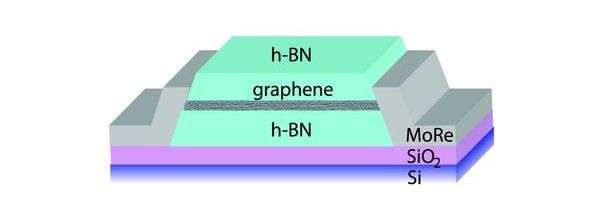May 20, 2016 report
New type of Andreev process predicted whereby electron and hole states on opposite sample edges carry supercurrent

(Phys.org)—A team of researchers affiliated with several institutions in the U.S. and Japan has predicted a new type of process whereby electron and hole states on opposite sample edges can carry supercurrent. In their paper, published in the journal Science, the team describes their technique, which involved using encapsulated graphene samples. Nadya Mason with University of Illinois offers a closer look at the work done by the team in a perspective published in the same journal issue.
As Mason notes, the general means for causing current to move between two superconductor materials involves placing a barrier between them and then causing the Cooper pairs to be ferried across via electrons and holes—notably, in situations where the superconductors are connected to a quantum Hall state, only one-way paths along the junction can be traversed.
But, the researchers wondered, what might happen if a very strong magnetic field were introduced into the junction, causing the charge carriers to move along only on the edges of the barrier? To find out, they assembled a mechanism that involved two superconducting materials separated by encapsulated graphene samples, and then created magnetic fields as high as two tesla. In such a setup, an entirely new type of Andreev process was predicted to occur in which electrons and hole states that existed on sample edges opposite one another would carry the supercurrent—this was predicted 20 years ago.
Prior efforts to create a device capable of verifying the prediction have been hampered, Mason, notes, by the problem of creating an environment where superconducting and quantum Hall states might coexist. In this new effort, graphene samples allowed the team to take a first step toward proving the theory and confirming the new physics that occurs when two correlated states are connected—the work also suggests that a host of hybrid systems could be on the horizon, opening the door to a wide variety of quantum transport behavior which, as Mason also notes, could lead to a range of unique excitations and possibly yet-to-be-imagined devices.
More information: F. Amet et al. Supercurrent in the quantum Hall regime, Science (2016). DOI: 10.1126/science.aad6203
Abstract
A promising route for creating topological states and excitations is to combine superconductivity and the quantum Hall (QH) effect. Despite this potential, signatures of superconductivity in the QH regime remain scarce, and a superconducting current through a QH weak link has been challenging to observe. We demonstrate the existence of a distinct supercurrent mechanism in encapsulated graphene samples contacted by superconducting electrodes, in magnetic fields as high as 2 tesla. The observation of a supercurrent in the QH regime marks an important step in the quest for exotic topological excitations, such as Majorana fermions and parafermions, which may find applications in fault-tolerant quantum computing.
Journal information: Science
© 2016 Phys.org





















